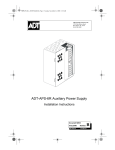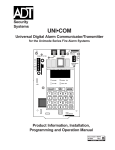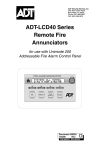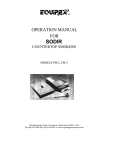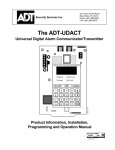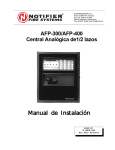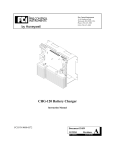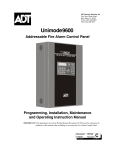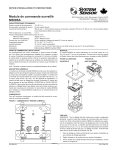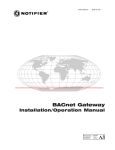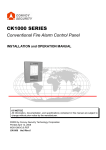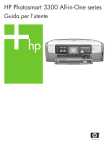Download ADT Security Services Medical Alarms Universal Zone Coder User's Manual
Transcript
Security Services Inc. One Town Center Road Boca Raton, FL 33431 Phone: (561) 988-3600 FAX: (561) 988-3675 ADT-UZC-256 UNIVERSAL ZONE CODER THE for the Unimode® 2020/1010, Unimode® II and Unimode® 4-16 Fire Alarm Control Panels Document 51349 4/25/00 Rev: A15216:D D ECN 99-402 Fire Alarm System Limitations While a fire alarm system may lower insurance rates, it is not a substitute for fire insurance! An automatic fire alarm system–typically made up of smoke detectors, heat detectors, manual pull stations, audible warning devices, and a fire alarm control with remote notification capability–can provide early warning of a developing fire. Such a system, however, does not assure protection against property damage or loss of life resulting from a fire. Heat detectors do not sense particles of combustion and alarm only when heat on their sensors increases at a predetermined rate or reaches a predetermined level. Rate-of-rise heat detectors may be subject to reduced sensitivity over time. For this reason, the rate-of-rise feature of each detector should be tested at least once per year by a qualified fire protection specialist. Heat detectors are designed to protect property, not life. The Manufacturer recommends that smoke and/or heat detectors be located throughout a protected premise following the recommendations of the current edition of the National Fire Protection Association Standard 72 (NFPA 72), manufacturer's recommendations, State and local codes, and the recommendations contained in the Guide for Proper Use of System Smoke Detectors, which is made available at no charge to all installing dealers. A study by the Federal Emergency Management Agency (an agency of the United States government) indicated that smoke detectors may not go off in as many as 35% of all fires. While fire alarm systems are designed to provide early warning against fire, they do not guarantee warning or protection against fire. A fire alarm system may not provide timely or adequate warning, or simply may not function, for a variety of reasons: Smoke detectors may not sense fire where smoke cannot reach the detectors such as in chimneys, in or behind walls, on roofs, or on the other side of closed doors. Smoke detectors also may not sense a fire on another level or floor of a building. A second-floor detector, for example, may not sense a first-floor or basement fire. Particles of combustion or "smoke" from a developing fire may not reach the sensing chambers of smoke detectors because: • Barriers such as closed or partially closed doors, walls, or chimneys may inhibit particle or smoke flow. • Smoke particles may become "cold," stratify, and not reach the ceiling or upper walls where detectors are located. • Smoke particles may be blown away from detectors by air outlets. • Smoke detectors may be drawn into air returns before reaching the detector. The amount of "smoke" present may be insufficient to alarm smoke detectors. Smoke detectors are designed to alarm at various levels of smoke density. If such density levels are not created by a developing fire at the location of detectors, the detectors will not go into alarm. Smoke detectors, even when working properly, have sensing limitations. Detectors that have photoelectronic sensing chambers tend to detect smoldering fires better than flaming fires, which have little visible smoke. Detectors that have ionizing-type sensing chambers tend to detect fast-flaming fires better than smoldering fires. Because fires develop in different ways and are often unpredictable in their growth, neither type of detector is necessarily best and a given type of detector may not provide adequate warning of a fire. Smoke detectors cannot be expected to provide adequate warning of fires caused by arson, children playing with matches (especially in bedrooms), smoking in bed, and violent explosions (caused by escaping gas, improper storage of flammable materials, etc.). Precau-Lg.p65 01/18/2000 IMPORTANT! Smoke detectors must be installed in the same room as the control panel and in rooms used by the system for the connection of alarm transmission wiring, communications, signaling, and/or power. If detectors are not so located, a developing fire may damage the alarm system, crippling its ability to report a fire. Audible warning devices such as bells may not alert people if these devices are located on the other side of closed or partly open doors or are located on another floor of a building. Any warning device may fail to alert people with a disability or those who have recently consumed drugs, alcohol or medication. Please note that: • Strobes can, under certain circumstances, cause seizures in people with conditions such as epilepsy. • Studies have shown that certain people, even when they hear a fire alarm signal, do not respond or comprehend the meaning of the signal. It is the property owner's responsibility to conduct fire drills and other training exercise to make people aware of fire alarm signals and instruct them on the proper reaction to alarm signals. • In rare instances, the sounding of a warning device can cause temporary or permanent hearing loss. A fire alarm system will not operate without any electrical power. If AC power fails, the system will operate from standby batteries only for a specified time and only if the batteries have been properly maintained and replaced regularly. Equipment used in the system may not be technically compatible with the control. It is essential to use only equipment listed for service with your control panel. Telephone lines needed to transmit alarm signals from a premise to a central monitoring station may be out of service or temporarily disabled. For added protection against telephone line failure, backup radio transmission systems are recommended. The most common cause of fire alarm malfunction is inadequate maintenance. To keep the entire fire alarm system in excellent working order, ongoing maintenance is required per the manufacturer's recommendations, and UL and NFPA standards. At a minimum, the requirements of Chapter 7 of NFPA 72 shall be followed. Environments with large amounts of dust, dirt or high air velocity require more frequent maintenance. A maintenance agreement should be arranged through the local manufacturer's representative. Maintenance should be scheduled monthly or as required by National and/ or local fire codes and should be performed by authorized professional fire alarm installers only. Adequate written records of all inspections should be kept. Installation Precautions Adherence to the following will aid in problem-free installation with long-term reliability: WARNING - Several different sources of power can be connected to the fire alarm control panel. Disconnect all sources of power before servicing. Control unit and associated equipment may be damaged by removing and/or inserting cards, modules, or interconnecting cables while the unit is energized. Do not attempt to install, service, or operate this unit until this manual is read and understood. CAUTION - System Reacceptance Test after Software Changes. To ensure proper system operation, this product must be tested in accordance with NFPA 72 Chapter 7 after any programming operation or change in site-specific software. Reacceptance testing is required after any change, addition or deletion of system components, or after any modification, repair or adjustment to system hardware or wiring. All components, circuits, system operations, or software functions known to be affected by a change must be 100% tested. In addition, to ensure that other operations are not inadvertently affected, at least 10% of initiating devices that are not directly affected by the change, up to a maximum of 50 devices, must also be tested and proper system operation verified. This system meets NFPA requirements for operation at 0-49° C/32-120° F and at a relative humidity of 85% RH (noncondensing) at 30° C/86° F. However, the useful life of the system's standby batteries and the electronic components may be adversely affected by extreme temperature ranges and humidity. Therefore, it is recommended that this system and all peripherals be installed in an environment with a nominal room temperature of 15-27° C/60-80° F. Verify that wire sizes are adequate for all initiating and indicating device loops. Most devices cannot tolerate more than a 10% I.R. drop from the specified device voltage. Like all solid state electronic devices, this system may operate erratically or can be damaged when subjected to lightning-induced transients. Although no system is completely immune from lightning transients and interferences, proper grounding will reduce susceptibility. Overhead or outside aerial wiring is not recommended, due to an increased susceptibility to nearby lightning strikes. Consult with the Technical Services Department if any problems are anticipated or encountered. Disconnect AC power and batteries prior to removing or inserting circuit boards. Failure to do so can damage circuits. Remove all electronic assemblies prior to any drilling, filing, reaming, or punching of the enclosure. When possible, make all cable entries from the sides or rear. Before making modifications, verify that they will not interfere with battery, transformer, and printed circuit board location. Do not tighten screw terminals more than 9 in-lbs. Over-tightening may damage threads, resulting in reduced terminal contact pressure and difficulty with screw terminal removal. Though designed to last many years, system components can fail at any time. This system contains static-sensitive components. Always ground yourself with a proper wrist strap before handling any circuits so that static charges are removed from the body. Use static-suppressive packaging to protect electronic assemblies removed from the unit. Follow the instructions in the installation, operating, and programming manuals. These instructions must be followed to avoid damage to the control panel and associated equipment. FACP operation and reliability depend upon proper installation by authorized personnel. FCC Warning WARNING: This equipment generates, uses, and can radiate radio frequency energy and if not installed and used in accordance with the instruction manual, may cause interference to radio communications. It has been tested and found to comply with the limits for class A computing device pursuant to Subpart B of Part 15 of FCC Rules, which is designed to provide reasonable protection against such interference when operated in a commercial environment. Operation of this equipment in a residential area is likely to cause interference, in which case the user will be required to correct the interference at his own expense. Canadian Requirements This digital apparatus does not exceed the Class A limits for radiation noise emissions from digital apparatus set out in the Radio Interference Regulations of the Canadian Department of Communications. Le present appareil numerique n'emet pas de bruits radioelectriques depassant les limites applicables aux appareils numeriques de la classe A prescrites dans le Reglement sur le brouillage radioelectrique edicte par le ministere des Communications du Canada. Precau-Lg.p65 01/18/2000 Contents Section One: ADT-UZC-256 Universal Zone Coder ......................................................... 5 Section Two: Board Description ......................................................................................... 7 Section Three: Installing the ADT-UZC-256 ....................................................................... 8 Unimode II Installation ................................................................................. 8 Figure 3-1: Mounting the ADT-UZC-256 to a CHS-4 ................................. 8 Unimode 4-16 Installation ............................................................................ 9 Figure 3-2: Mounting the ADT-UZC-256 in the ADT-CAB-500 .......................... 9 Unimode 2020/1010 Installation ................................................................ 10 Figure 3-3: Mounting the ADT-UZC-256 in an ICA-4L chassis ............... 10 Section Four: Power/NAC Configurations ....................................................................... 11 Section Five: Unimode 2020/1010 / ADT-UZC-256 Configuration ................................ 13 Section Six: ADT-UZC-256 Connections to M300CADT Modules .............................. 14 Appendix A: Plug/Terminal Schematic ........................................................................... 15 4 51349:D 4/25/00 Section One: ADT-UZC-256 Universal Zone Coder General The ADT-UZC-256 Universal Zone Coder provides separate codes for up to 256 initiating zones. Each code requires a different initiating circuit. Only one Notification Appliance Circuit is required, but coded output from the ADT-UZC-256 can be fed to many output circuits. Coded Outputs The ADT-UZC-256 contains three outputs, each rated for three amps at 30 VDC. These outputs allow the ADT-UZC-256 to supply different coded information to certain output circuits, depending on the alarm initiation condition. This can be useful when employing coded outputs in floor-above, floor-below applications, or to provide various numbers of rounds for bell circuits and strobe or lamp circuits. These relays are controlled by a predefined program, and can be set to respond to general alarm conditions with the fire alarm system. The ADT-UZC-256 also provides a second zonein-alarm override of the general alarm delay. EIA-485 Communication The ADT-UZC-256 and the CPU use the EIA-485 circuit for communication. When installed, the zone coder automatically assumes the lowest available address on the EIA-485 interface. Unimode 4-16 Unimode II Unimode 2020/1010 # of Points 1-56 1-56 57-120 1-64 65-128 129-192 193-256 Addresses 1 1 2 1 2 3 4 Assignment of points to zone codes within the ADT-UZC-256 is automatic in the Unimode II and Unimode 4-16. It is programmable in the Unimode 2020/1010. Addresses occupied by the ADT-UZC-256 are unavailable to other devices on the EIA-485 circuit (AMG, annunciators, etc.). Zone Code Protocol The ADT-UZC-256 allows the specification of several parameters: • • • • • Up to four code digits. Number of rounds Pulse-ON, Pulse-OFF time Time between digits Time between rounds Note: Due to the nature of coded outputs, the ADT-UZC-256 is not compatible with notification appliances which do not produce a steady sound. Periodic appliances that produce their own code (such as some codes available with electronic sounders) will not be compatible with the ADT-UZC-256; some appliances may have a response time which is too slow to operate with the programmed code. 51349:D 4/25/00 5 Mounting The ADT-UZC-256 plugs into the ICA-4L in Unimode 2020/1010 systems, or mounts behind modules in the Unimode 4-16 and Unimode II. Additional Reference The ADT-UZC-256 Zone Coder can be used with the Unimode 4-16, the Unimode II, and the Unimode 2020/1010 Fire Alarm Control Panels. For more information on these systems, refer to the following documents: The Unimode 4-16 Installation & Programming Manual, Document A15019 The Unimode II Installation Manual, Document A15583 The Unimode 2020/1010 Manual, Document 51167 Standby Battery Calculation Use the following figures when calculating the required standby battery capacity as indicated in the above-mentioned installation manuals: Standby Load: 35mA Alarm Load: 85mA 6 51349:D 4/25/00 Section Two: Board Description TROUBLE LED (Yellow) Power Supervision Lights when one or more trouble conditions are detected. ALARM TEST (Red) Follows the main coded output. EIA-232 Connection* Female DB-9 connector for programming from an IBM-compatible computer. SLC ON-LINE LED (Green) Blinks during communication with the master FACP. EIA-485 Connection* All connections are power limited and supervised. See diagram below for terminal assignment. Notification Appliance Circuit Power Connections* See diagram below for terminal/connector designations. POWER OUT (Unimode II and Unimode 4-16 Mode Select Switch only) to next device in power chain. for normal/programming mode selection. POWER IN* (Unimode II and Unimode 4-16 Power Connector* (for the Unimode 2020/ only) connection to main power supply. 1010) 9V POWER CONNECTOR for powering the ADT-UZC-256 during remote programming. * use a power limited power supply Power Connections for Notification Appliance Circuits CKT 3 CKT 1 OUT IN CKT 2 OUT CKT 3 IN OUT IN (+) (+) OUT IN (-) (-) OUT IN CKT 2 CKT 1 NC COM NO NC COM REF. NC COM NO 51349:D 4/25/00 NO 7 Section Three: Installing the ADT-UZC-256 Unimode II Installation Mechanical Installation The ADT-UZC-256 mounts beneath the third and fourth modules, to the right of the CPU. The ADT-UZC-256 fastens to the base of the CHS-4 chassis using the four hex standoffs (provided), which are screwed onto four PEM studs. The ADT-UZC-256 is then attached to three of the four standoffs using the mounting screws provided (see Figure 3 - 1). ADT-UZC-256 ADT-UZC-256 STEP 1 CHS--4 STEP 2 Figure 3-1: Mounting the ADT-UZC-256 to a CHS-4 Electrical Installation Connect the main power harness from the MPS power supply to P3 on the ADT-UZC-256. Connect the short power harness (provided) from P2 on the ADT-UZC-256 to the CPU-5000. See Section Two for all terminal assignments. Connect the EIA-485 annunciator signal from the two-terminal connector on the lower CPU board (TB-2) to the ADT-UZC-256 EIA-485 IN terminals. For connection of notification appliance power to and from the ADT-UZC-256, refer to the power configuration illustrations in Section Four. 8 51349:D 4/25/00 Unimode 4-16 Installation Mechanical Installation In a Unimode 4-16, the ADT-UZC-256 mounts beneath the third (right most) module. The ADT-UZC-256 fastens to the back of the box using three hex standoffs (one aluminum and two nylon provided), which are screwed into the three female PEM nuts as shown. The ADT-UZC-256 is then attached to two of the four standoffs using captive screws on the board (see Figure 3 - 2). ADT-UZC-256 ADT-UZC-256 STEP 1 CAB--500 STEP 2 Figure 3-2: Mounting the ADT-UZC-256 in the ADT-CAB-500 Electrical Installation Connect the main power harness from the Unimode 4-16 power supply to P3 on the ADT-UZC-256. Connect the power harness provided with the ADT-UZC-256 from P2 on the ADT-UZC-256 to the CPU-500. See Section Two for all terminal assignments. Connect the EIA-485 annunciator signal from the two-terminal connector on the lower CPU board (TB-2) to the EIA-485 IN terminals on the ADT-UZC-256. For connection of notification appliance power to and from the ADT-UZC-256, refer to the power configuration illustrations in Section Four. 51349:D 4/25/00 9 Unimode 2020/1010 Installation Mechanical Installation In a Unimode 2020/1010, the ADT-UZC-256 plugs into a slot on the ICA-4L chassis. If the Unimode 2020/1010 is in an A-size cabinet (only one ICA-4L), the ADT-UZC-256 mounts beneath the CPU or the SIB. If a second or third ICA-4L chassis is available, the ADT-UZC-256 should be mounted in one of the two upper slots to permit easy access to ADT-UZC-256 wiring and switch settings. Note that the ADT-UZC-256 mechanically eliminates one LIB position, requiring the installation of an additional chassis in some instances. As an alternative, the Unimode 2020/1010 may use a CHS-4 chassis to mount the ADT-UZC-256 (see Figure 3 - 3). Note also that the Unimode 2020/1010 does not require LIB boards to be installed in consecutive positions. For example, in a five-loop system, the ADT-UZC-256 could be installed in LIB position 3 (upper left of second chassis), with LIBs in all other slots. In this case, the Unimode 2020/1010 would be programmed for loops 1, 2, 4, 5, and 6. Figure 3-3: Mounting the ADT-UZC-256 in an ICA-4L Chassis 10 51349:D 4/25/00 Section Four: Power/NAC Configurations These two Notification Appliance Circuits share 3.0 amps of coded power. ADT-UZC256 ADT-UZC256 These six Notification Appliance Circuits share 3.0 amps of coded power. ADT-UZC256 These ten Notification Appliance Circuits share 3.0 amps of coded power. These two Notification Appliance Circuits share 3.0 amps of coded power. ADT-UZC256 These four Notification Appliance Circuits share 3.0 amps of coded power. ADTAPS-6R NOTE: Cable from MPS to ADT-UZC-256: P/N 71093; all others: P/N 71091. 51349:D 4/25/00 11 These two Notification Appliance Circuits share 3.0 amps of coded power. ADT-UZC256 ADTAPS-6R These eight Notification Appliance Circuits share 3.0 amps of coded power. These two Notification Appliance Circuits share 3.0 amps of coded power. ADT-UZC256 ADTAPS-6R These four Notification Appliance Circuits share 3.0 amps of coded power. These four Notification Appliance Circuits share 3.0 amps of coded power. ADTAPS-6R These two Notification Appliance Circuits share 3.0 amps of coded power. ADT-UZC256 These two Notification Appliance Circuits share 3.0 amps of coded power. ADTAPS-6R ADTAPS-6R 12 Cut JP1 on the ICM-4. 51349:D 4/25/00 These two Notification Appliance Circuits share 3.0 amps of coded power. Section Five: Unimode 2020/1010 / ADT-UZC-256 Configuration LIB-200A CCM-1 ADT-SIB-NET CPU-2020 EIA-232 CRT ADT-LCD-80 EIA-485 SLC XPM XPP-1 XPC-8 Universal Zone Coder ADT-UZC-256 ARM-4 3 AMP MAX. Bell Power BATTERY BATTERY 51349:D 4/25/00 UZC-2020.CDR MPS-24A 13 Section Six: ADT-UZC-256 Connections to M300CADT Modules The following illustration shows connections to an M300CADT control module. For wiring other types of control modules, refer to the specific literature for that module. System Sensor A2143-00 (Canada: N-ELR) End-of-Line Resistor, 47K, .5 watts, supervised and power-limited + + 24VDC Notification Appliance (See Device Compatibility Document 51352 for compatible devices) + + - + SLC to Next Device M300CADT + - SLC OUT 1 ADT-AIM-200 or Unimode 2020/1010 14 2 3 4 5 6 NO COM NC NO COM NC TB1 ADT-UZC-256 51349:D 4/25/00 + MPS-24A, TB3 Terminal 4 (-) and 3 (+) or MPS-24B,TB2 Terminal 4 (-) and 3 (+) or UL listed 24VDC power limited, resettable power supply for Fire Protective Signaling Power Input 1 Coded Output 1 Power Input 2 Coded Output 2 Power Input 3 Coded Output 3 Appendix A: Plug/Terminal Schematic 3 Code Relay 3 Coded Outputs 2 1 Code Relay 2 Code Relay 1 51349:D 4/25/00 15















